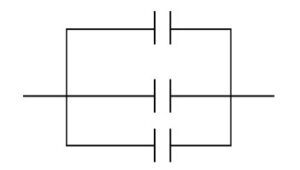Question

Three 3 µF capacitors are connected in parallel as shown above.Determine the equivalent capacitance of the arrangement.
(A) $\frac{1}{3}$ µF
(B) 1 µF
(C) 3 µF
(D) 6 µF
(E) 9 µF
▶️Answer/Explanation
Ans: E
The equivalent capacitance of capacitors connected in parallel is the sum of each capacitor. Therefore: Ceq = 3 + 3 + 3 = 9 µF.
Question

A solid, neutral metal sphere of radius 6a contains a small cavity, a spherical hole of radius a as shown above. Within this cavity is a charge, +q. If Ex and Ey denote the strength of the electric field at points X and Y, respectively, which of the following is true?
(A)Ey= 4-Ex
(B)Ey= 16Ex
(C)Ey=Ex
(D) Ey = (11/5)Ex
(E) Ey = (11/5)2Ex
▶️Answer/Explanation
Ans: C
If a conducting sphere contains a charge of +q within an inner cavity, a charge of -q will move to the wall of the cavity to “guard” the interior of the sphere from an electrostatic field, regardless of the size, shape, or location of the cavity. As a result, a charge of +q is left on the exterior of the sphere (and it will be uniform). So, at points outside the sphere, the sphere behaves as if this charge +q were concentrated at its center, so the electric field outside is simply kQ/r2. Since points X and Y are at the same distance from the center of the sphere, the electric field strength at Y will be the same as at X.
Question
A particular microwave requires some power, P, to operate. In America, a typical outlet provides electricity at 120 V. This would send a current, I, to the microwave. If this same microwave were taken to Europe, where the outlets provide twice the voltage, what would be the new current?
(A) \(\frac{1}{4}I\)
(B) \(\frac{1}{2}I\)
(C) I
(D) 2I
(E) 4I
▶️Answer/Explanation
Ans: B
Using the equation P = Iv, we see current and voltage are inversely proportional if power is held constant. Since the voltage in the question doubled, the current must be halved.
Question

A uniform electric field exists in a region, and then a neutral, conducting, spherical shell with a stationary charge +2Q at its center is placed in the region, as shown above. The radius of the sphere is R. The flux through the sphere depends on the value of
(A) E, Q, and R
(B) Only R
(C) E and Q
(D)R and Q
(E) Only Q
▶️Answer/Explanation
Ans: E
The flux is proportional to the number of field lines that pass through the surface of the sphere. Since the background electric field E is uniform, every background field line that enters the sphere also exits the sphere. Therefore, it has no contribution to the flux. The field lines from the +2Q charge will radiate outward and every field line that exists due to the +2Q will pass through the sphere, regardless of R. Therefore, the flux only depends on the value of Q. This is in accordance with Gauss’s law.
